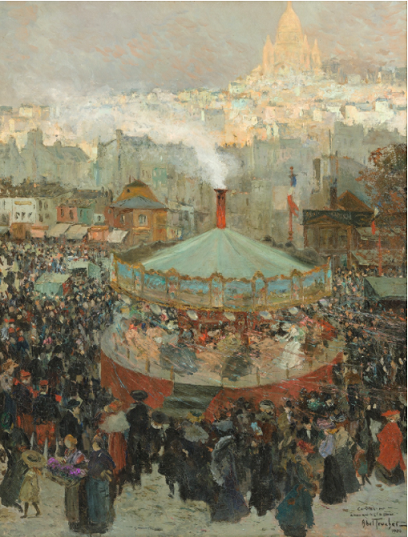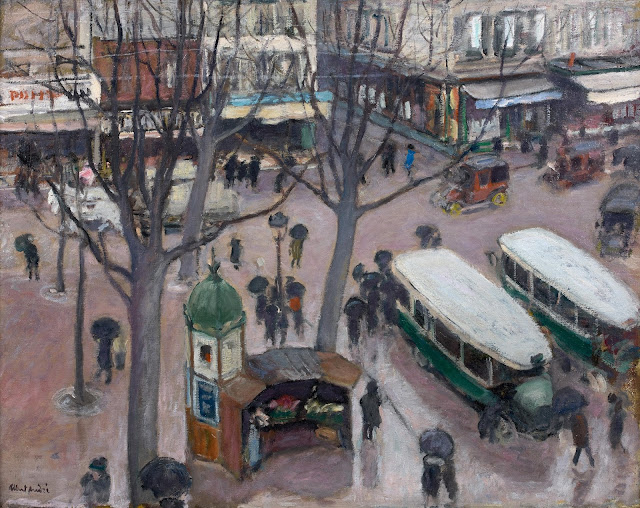Paris, France's capital, is a major European city and a global center for art, fashion, gastronomy and culture. Its 19th-century cityscape is crisscrossed by wide boulevards and the River Seine. Beyond such landmarks as the Eiffel Tower and the 12th-century, Gothic Notre-Dame cathedral, the city is known for its cafe culture and designer boutiques along the Rue du Faubourg Saint-Honoré. More on Paris
Louis Abel-Truchet, VERSAILLES 1857 - 1918 AUXERRE
FAIRGROUND WITH THE SACRÉ-COEUR IN THE BACKGROUND, c. 1904
Oil on canvas
90,5 x 70 cm ; 35 5/8 by 27 1/2 in.
Private collection
The Basilica of the Sacred Heart of Paris is
a Roman Catholic church and minor basilica, dedicated to the Sacred Heart of
Jesus. The basilica is located at the summit of the butte Montmartre, the
highest point in the city. Sacré-Cœur is a double monument, political and
cultural, both a national penance for the defeat of France in the 1871
Franco-Prussian War and the socialist Paris Commune of 1871 crowning its most
rebellious neighborhood, and an embodiment of conservative moral order
The Sacré-Cœur Basilica was designed by Paul Abadie.
Construction began in 1875 and was finished in 1914. It was consecrated after
the end of World War I in 1919. More on the Basilica
Louis Abel-Truchet, 1857 - 1918, was an important French painter, etcher and lithographer in
his lifetime. He was born in 1857 in Versailles. He is predominantly known for
his paintings depicting Paris at the turn of the century, with cafés, theatres,
shops, everyday life and fashionable Parisians forming an essential part of the
subject matter.
He
exhibited from 1891 in various salons and was a founding member of the Salon
d'Automne and the Societe des Humoristes. He also exhibited at the Salon des
Artistes Français and the Société Nationale des Beaux-Arts, becoming a member
in 1910.
Though
influenced by impressionism, Abel-Truchet is also satirical at times and his
work focused on the Belle Epoque, linking him with artists such as
Galien-Laloue, Forain and Steinlen.
In 1914, aged fifty seven, he volunteered to
fight in the World War One. He was to produce a series of lithographs depicting
scenes from his experiences. He commanded a section of fighting troops during
the war and was awarded the Legion of Honour and La Croix de Guerre.
Abel-Truchet died in service in the last few months of the war. More on Louis Abel-Truchet
Louis Abel-Truchet, VERSAILLES 1857 - 1918 AUXERRE
Paris, les autobus, place Pigalle - 1920
Oil on canvas
65 x 81 cm
Private collection
Louis Abel-Truchet, VERSAILLES 1857 - 1918 AUXERRE, FRENCH
FAIRGROUND, PLACE PIGALLE
Oil on canvas
46 x 38 cm ; 18 by 15 in.
Private collection
The Place Pigalle is a public square located in the 9th arrondissement of Paris, between the Boulevard de Clichy and the Boulevard de Rochechouart, near Sacré-Cœur, at the foot of the Montmartre hill. The place takes its name from the sculptor, Jean-Baptiste Pigalle (1714–1785), and it is the best-known district of the Quartier Pigalle, the Pigalle district.
The square and the surrounding streets were, at the end of the 19th century, a neighbourhood of painters' studios and literary cafés. More on The Place Pigalle
Louis Abel-Truchet, see above
Abraham de Verwer, HAARLEM 1585 - 1650 AMSTERDAM
VIEW OF PARIS FROM THE PONT-ROYAL WITH THE GRANDE GALERIE DU LOUVRE, THE PONT-NEUF AND THE NESLE TOWER, c. 1664
Oil on panel
54 x 90 cm ; 21 1/4 by 35 1/2 in
Private collection
The Pont Royal is a bridge crossing the river Seine in Paris. It is the third oldest bridge in Paris, after the Pont Neuf and the Pont Marie. The Pont Royal links the Right Bank by the Pavillon de Flore with the Left Bank of Paris between rue du Bac and the rue de Beaune. The bridge is constructed with five elliptical arches en plein cintre. A hydrographic ladder, indicating floods' highest level in Paris, is visible on the last pier nearest each bank. More on The Pont Royal
Abraham de Verwer (1585, Haarlem – 1650, Amsterdam), was a Dutch Golden Age painter of cityscapes, (river) landscapes and seascapes. He was also called Abraham de Verweer van Burghstrate. He travelled in northern France and when he returned, he settled in Amsterdam. It is unknown who taught him to paint, but he was noted in his wife's testament in Haarlem in 1607 as a "schrijnwerker" or cabinet-maker, and in 1614 he was noted in an Amsterdam estate inventory as a painter. He travelled in France from 1637-1639. He was the father of the Amsterdam poet Catharina Verwers and the Amsterdam painter Justus de Verwer. More on Abraham de Verwer
Lucien GENIN, 1894 - 1958
At the restaurant
Gouache on paper
Height: 23,50 Width: 31 cm
Private collection
Lucien Génin (9 November 1894 in Rouen – 26 August 1953 in Paris) was a French painter in the milieu of pre-World War I, and 1920s Montmartre and Saint-Germain-des-Prés.
After the devastation of the First World War, Lucien left his provincial home in the autumn of 1919 to find his fortune among the lively Parisians in the heart of Montmartre. Not concerning himself with producing “art”, he beautifully captured the spirit if Paris between the wars while enjoying a truly Bohemian existence. Genin’s works in all their forms, perfectly convey these eclectic and friendly characters of the city and he was so well loved that one collector said “separate me from my Vlaminck, my foujita, my Derain, my Dunoyer de Segonzac and I will survive…but my Genin, never!”. More on Lucien Génin
Francois Gerome, French, 1895-?
Boulevard Montparnasse, Paris
Oil on canvas
24 x 30 inches
Private collection
The Boulevard du Montparnasse is a two-way boulevard in Montparnasse, in the 6th, 14th & 15th arrondissements in Paris. Students in the 17th century who came to recite poetry in the hilly neighbourhood nicknamed it after "Mount Parnassus", home to the nine Muses of arts and sciences in Greek mythology.
The hill was levelled to construct the Boulevard Montparnasse in the 18th century. During the French Revolution many dance halls and cabarets opened their doors.
The area is also known for cafés and bars, such as the Breton restaurants specialising in crêpes located a few blocks from the Gare Montparnasse. More on The Boulevard du Montparnasse
François Gérôme (born 1895 in Paris) was a French painter. He is best known for his paintings of women depicted at picturesque spots throughout Paris including the Place de la Concorde and in front of the Opéra. In these representations, the women usually engage the viewer with their frontal pose and direct gaze outward. Gerome used oils, typically on canvas or on board. He signed his paintings with his first initial and last name, but was also known to sign in his alias B. Kovacs. More on François Gérôme
Ramon PICHOT GIRONES, 1872 - 1925
Gitanes on the plaza
Watercolor, pastel and charcoal on paper mounted on cardboard
Height: 44 Width: 32 cm
Private collection
Ramon Pichot Gironès (Catalan; 1871 – 1 March 1925) was a Catalan and Spanish artist. He painted in an impressionist style. He was a good friend of Pablo Picasso and an early mentor to young Salvador Dalí. Dalí met Pichot in Cadaqués, Spain, when was only 10 years old. Pichot also made many trips to France. Once in a while, Dalí and his family would go on a trip with Pichot and his family.
He married Germaine Pichot, a well-known artist's model, in 1906. Together they had a restaurant near the Bateau Lavoir, called La maison rose. Pichot left Paris after World War I but returned often to buy books, as he had turned into a bibliophile. On such a trip, he suddenly died on 1 March 1925. Picasso was so shaken by this that he included Pichot's figure in the painting "Three Dancers", on which he was working at the time. More on Ramon Pichot Gironè
John Duncan Fergusson, Scottish (1874 - 1961)
La Terrasse, Café d'Harcourt, c. 1908 - 1909
Oil on canvas
108.60 x 122.00 cm
Scottish National Gallery Of Modern Art
This painting depicts the terrace of the fashionable Café d'Harcourt, on the Boulevard St Michel, opposite the Sorbonne University in Paris. Fergusson immensely enjoyed being part of the 'café society.' An outgoing character, he was part of a group of Anglo-American artists who made the café the centre of their social and intellectual life. Fergusson has flattened the perspective in this painting, drawing attention to surface pattern. The use of flat, bright areas of colour in particular, the green shadows in the face of the man on the right of the painting shows the influence of Matisse and the fauvist painters. More on this painting
John Duncan Fergusson, (b Leith , 9 Mar.
1874; d Glasgow, 30 Jan. 1961). Scottish
painter (mainly of landscapes and figure subjects) and occasional sculptor, the
best known of the Scottish Colourists. From about 1895 he made regular visits
to Paris and he lived there 1907–14. His early work was Whistlerian and he then
came under the influence of Manet, but by 1907 he had adopted the bold palette
of Fauvism and became the most uncompromising adherent to the style among
British artists (Blue Beads, 1910, Tate, London). More on John Duncan Fergusson
Lyonel Feininger
Strasse in Paris - Streets in Paris , 1918
Woodblock on Kozo paper
33.375 x 26.75 in
Private collection
Lyonel Charles Feininger (July 17, 1871 –
January 13, 1956) was a
German-American painter, and a leading exponent of Expressionism. He also
worked as a caricaturist and comic strip artist. He was born and grew up in New
York City, traveling to Germany at 16 to study and perfect his art. He started
his career as a cartoonist in 1894 and met with much success in this area. He
was also a commercial caricaturist for 20 years for magazines and newspapers in
the USA and Germany. At the age of 36, he started to work as a fine artist. He
also produced a large body of photographic works between 1928 and the mid
1950s, but he kept these primarily within his circle of friends. He was also a
pianist and composer, with several piano compositions and fugues for organ
extant. More on Lyonel Charles Feininger
Images are copyright of their respective owners, assignees or others
We do not sell art, art prints, framed posters or reproductions. Ads are shown only to compensate the hosting expenses.
If you enjoyed this post, please share with friends and family.












No comments:
Post a Comment